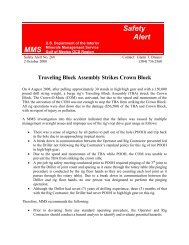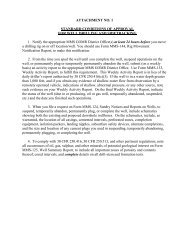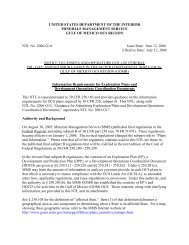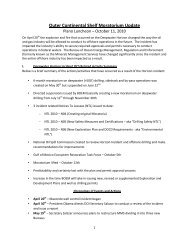Deepwater Gulf of Mexico 2004: America's Expanding ... - OCS BBS
Deepwater Gulf of Mexico 2004: America's Expanding ... - OCS BBS
Deepwater Gulf of Mexico 2004: America's Expanding ... - OCS BBS
- No tags were found...
You also want an ePaper? Increase the reach of your titles
YUMPU automatically turns print PDFs into web optimized ePapers that Google loves.
4,500<br />
4,000<br />
3,500<br />
Leases tested<br />
Leases expiring<br />
Untested leases in primary term<br />
3,000<br />
Number <strong>of</strong> Leases<br />
2,500<br />
2,000<br />
1,500<br />
1,000<br />
500<br />
0<br />
1985<br />
1986<br />
1987<br />
1988<br />
1989<br />
1990<br />
1991<br />
1992<br />
1993<br />
1994<br />
1995<br />
1996<br />
1997<br />
1998<br />
1999<br />
2000<br />
2001<br />
2002<br />
2003<br />
<strong>2004</strong><br />
2005<br />
2006<br />
2007<br />
2008<br />
2009<br />
2010<br />
2011<br />
2012<br />
Year<br />
Figure 78. The challenge <strong>of</strong> deepwater lease evaluation.<br />
from these sales, 11 <strong>of</strong> these wells resulted in announced discoveries. Figure 78 shows a steep decline in<br />
active leases as the large number <strong>of</strong> leases acquired in 1996 through 1998 start to expire. Note that this<br />
graph does not include the hundreds <strong>of</strong> new leases that will be added to the inventory each year from<br />
upcoming lease sales. The available deepwater rig fleet will challenge industry’s ability to evaluate their<br />
lease inventory, both current and future additions. Other factors play a significant role in the industry’s<br />
ability to evaluate their GOM lease inventory, including alternative deepwater exploration and<br />
development targets throughout the world, capital limitations, and limited qualified personnel.<br />
EXPANDING FRONTIER<br />
It is instructive to look back to the earlier deepwater reports (figure 79) and observe the dramatic<br />
increases in proved reserves and discovered volumes (which include proved and unproved reserves,<br />
resources, and industry-announced discoveries). Many <strong>of</strong> the discovered volumes in earlier reports have<br />
progressed to become proved reserves in subsequent reports. For example, in the last report, Thunder<br />
Horse was in the discovered-volumes category, and in this report its volumes are classified as proved<br />
reserves. While both proved reserves and discovered volumes have substantially increased from report to<br />
report, the most dramatic increases have occurred in the discovered volumes. This suggests a bright<br />
outlook for future deepwater production, as the less constrained resource and industry-announced<br />
volumes move into the reserve category and are produced.<br />
The future <strong>of</strong> deepwater GOM exploration and production remains very promising. As shown in<br />
figure 78, industry is nearing the end <strong>of</strong> the primary lease term <strong>of</strong> the exceptional number <strong>of</strong> leases<br />
acquired in 1996 through 1998. Traditional deepwater minibasin plays are far from mature, as several<br />
recent discoveries attest, and new deepwater plays near and even beyond the Sigsbee Escarpment, beneath<br />
thick salt canopies, and in lightly explored Paleogene reservoirs show that the deepwater GOM is an<br />
expanding frontier. As shown in figure 57, the immature deepwater creaming curve predicts that<br />
numerous large undiscovered fields remain. The 2000 Assessment indicates that more than 50 billion<br />
recoverable BOE remain to be discovered (Lore et al., 2001).<br />
111







